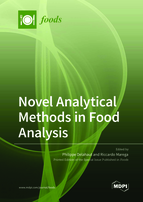Novel Analytical Methods in Food Analysis
A special issue of Foods (ISSN 2304-8158). This special issue belongs to the section "Food Analytical Methods".
Deadline for manuscript submissions: closed (25 August 2021) | Viewed by 46542
Special Issue Editors
Interests: analytical methods development and validation; immunoassay; mass spectrometry; veterinary drug residues; allergens; food security
Special Issue Information
Dear Colleagues,
Food analysis is a discipline with a huge impact on both economical and medical aspects of modern societies, being that it is at the cornerstone between industrial, medical, and regulatory needs.
The development of analytical methods in food matrices has always been difficult, due to the large variety of their physicochemical properties, which can change analyte structure and extraction efficiencies because of different processing throughout preparation and distribution.
On the one hand, such complexity can be tackled by a combination of sample preparation protocols and use of analytical instrumentation that is typically available in specialized laboratories, in terms of personnel and equipment (e.g., mass spectrometry analysis of food allergens). On the other hand, there is a great demand for the “decentralization” of analytical food methods by means of protocol simplification and on-site analysis (e.g., portable immunoassays). Furthermore, the simultaneous detection of multiple analytes at the same time (multiplexing) is an ongoing trend in the development of methods and instruments that increase throughput while lowering costs and operator intervention.
Integration of biological reactives (antibodies, aptamers), materials (nanoparticles, nanotubes), technologies (microspotting, microfluidics), and physical principles (spectroscopy and spectrometry) is, today, consolidating at both the academic and industrial levels, aiming at the exploration and control of the vast chemical space intersecting with food analysis.
Dr. Philippe Delahaut
Dr. Riccardo Marega
Guest Editors
Manuscript Submission Information
Manuscripts should be submitted online at www.mdpi.com by registering and logging in to this website. Once you are registered, click here to go to the submission form. Manuscripts can be submitted until the deadline. All submissions that pass pre-check are peer-reviewed. Accepted papers will be published continuously in the journal (as soon as accepted) and will be listed together on the special issue website. Research articles, review articles as well as short communications are invited. For planned papers, a title and short abstract (about 100 words) can be sent to the Editorial Office for announcement on this website.
Submitted manuscripts should not have been published previously, nor be under consideration for publication elsewhere (except conference proceedings papers). All manuscripts are thoroughly refereed through a single-blind peer-review process. A guide for authors and other relevant information for submission of manuscripts is available on the Instructions for Authors page. Foods is an international peer-reviewed open access semimonthly journal published by MDPI.
Please visit the Instructions for Authors page before submitting a manuscript. The Article Processing Charge (APC) for publication in this open access journal is 2900 CHF (Swiss Francs). Submitted papers should be well formatted and use good English. Authors may use MDPI's English editing service prior to publication or during author revisions.
Keywords
- analytical methods
- food security
- immunoassay
- mass spectrometry
- Raman spectroscopy
- NMR spectroscopy
- Flow cytometry
- portable assays
- sample preparation
- nanomaterials in diagnostics







